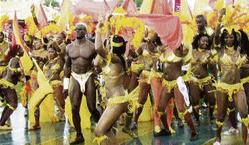André Jebbinson, Staff Reporter

Revellers take part in Grand Kadooment, the costume parade and road march that is the biggest part of the Crop Over festival in Barbados. -Photo by André Jebbinson
CARNIVAL IN Jamaica is long over and it may seem to be the last thing on people's mind, but not so in Barbados. The small eastern Caribbean island last weekend wrapped up its five-week carnival season, known as Crop Over.
One main thing both Jamaica's and Barbados' carnival have in common is the influx of energy that seems to be present during this time. However, there are some things that are not so similar. For example, Jamaica's carnival is put on by those in the private sector with big names, people like Richard Ammar and Byron Lee. In Barbados, it is the government that spearheads a majority of the Crop Over happenings. The National Cultural Foundation and the Barbados Tourist Authority are responsible for planning the event and ensuring others in the region support the carnival.
Secondly, from what was seen in last week's Grand Kadooment, the costume parade and road march, the bigger part of the day was presenting the bands and the costumes. Many, many spectators filled the stands to witness the varied colourful four-hour display of revellers and costume designs. Back in Jamaica, the larger part of the final day of carnival is reserved for the road march, where those in plainclothes and those in costume walk for miles to the beat of the music.
Another difference between the two is that the Barbadian carnival has historical value. It was traditionally a time to celebrate the end of a successful sugar cane season. The merriment dates back to as early as 1688 and was revived back in 1974, and other elements of Barbadian culture were infused to make the extravaganza that exists today. In fact, so important is Grand Kadooment to the Barbados culture, the day is set aside as a national holiday. Jamaica carnival, on the other hand, has no specific traditional cultura and was started less than 20 years ago. It is a spin-off of the grandest festival of its kind which takes place in Trinidad. However, there is calypso and soca history with Byron Lee, who started performing calypso as early as the 1950s.
And finally, your attire could be problematic if you like army fatigue. The army camouflage is reserved for soldiers only in Jamaica, but the rule is not so stringently applied . However, it is illegal for ordinary civilians to wear the print as they may appear to be impersonating a soldier. The Gleaner team learned that the hardway.
All in all, the spirit of carnival remain the same in both countries and around the region.

